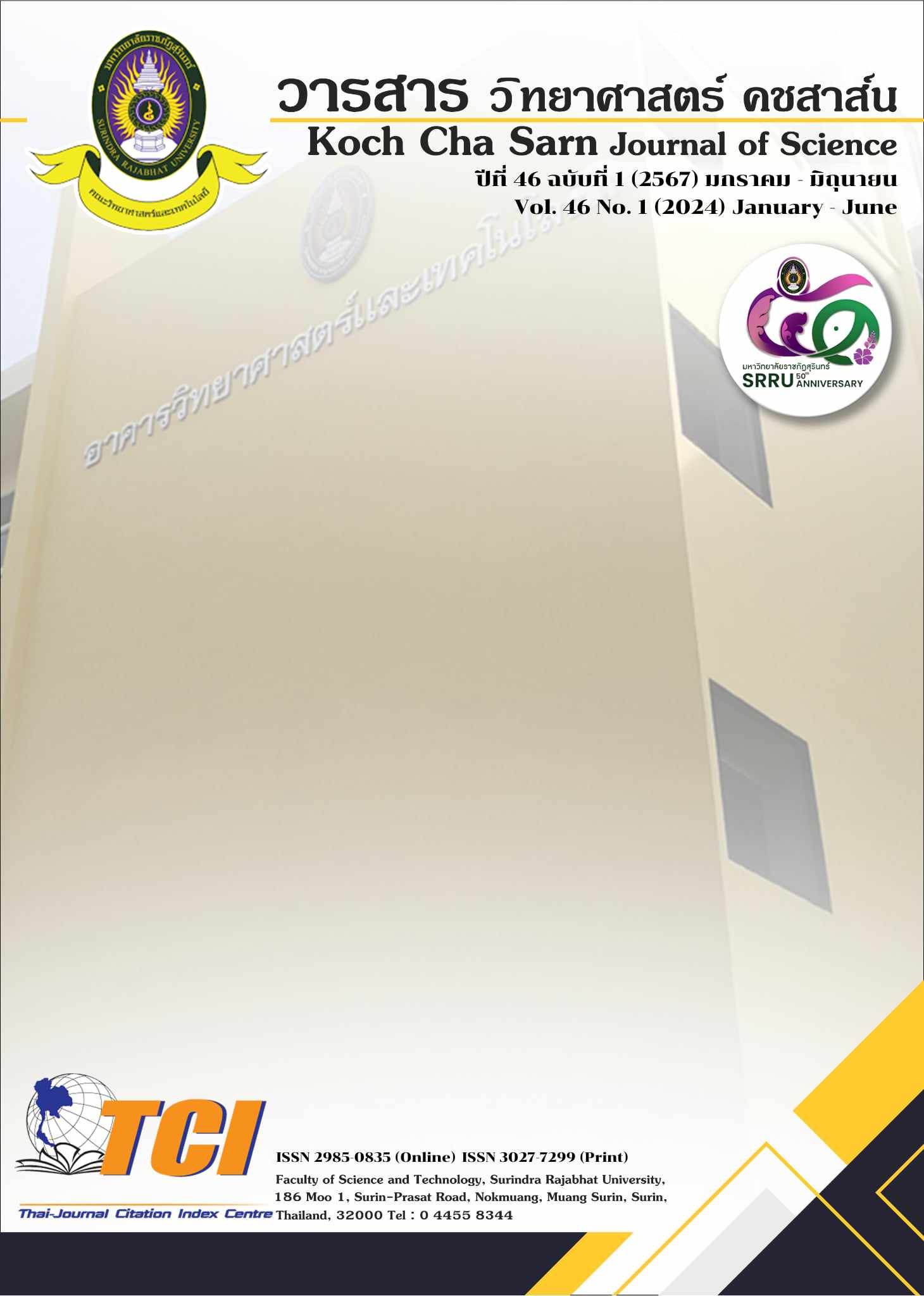การศึกษาสมบัติและความคงตัวของไมโครอิมัลชันบรรจุยาไอทราโคนาโซลสำหรับทาผิวหนัง
DOI:
https://doi.org/10.14456/kcsj.2024.1คำสำคัญ:
ยาไอทราโคนาโซล, ไมโครอิมัลชัน, ยาต้านเชื้อรา, ความคงตัวบทคัดย่อ
โรคผิวหนังจากเชื้อราเป็นโรคที่พบได้บ่อยในภูมิภาคเขตร้อนชื้นโดยทั่วไป โรคนี้สามารถรักษาได้ด้วยยาต้านเชื้อราโดยการรับประทานและการทาเฉพาะที่ ยาต้านเชื้อราในรูปแบบของเหลวสำหรับทาเฉพาะที่มีข้อดี คือ ลดการเกิดอาการไม่พึงประสงค์แบบทั่วร่างกาย ยาแผ่กระจายได้ทั่วบริเวณที่ทา และผู้ป่วยสามารถใช้ยาได้สะดวก การศึกษานี้มีวัตถุประสงค์เพื่อศึกษาระบบไมโครอิมัลชันในการเตรียมตำรับไอทราโคนาโซลไมโครอิมัลชันสำหรับใช้เฉพาะที่ โดยศึกษาการเกิดไมโครอิมัลชันในระบบที่แตกต่างกัน ซึ่งประกอบด้วยวัฏภาคน้ำมัน วัฏภาคน้ำ และสารลดแรงตึงผิว ต่างชนิดกันด้วยวิธีไทเทรต จากนั้นเลือกตำรับไมโครอิมัลชันเปล่าจากแผนภาพวัฏภาคที่มีพื้นที่ไมโครอิมัลชันขนาดใหญ่ เพื่อบรรจุยาไอทราโคนาโซลในความเข้มข้นร้อยละ 1 โดยน้ำหนัก สังเกตลักษณะของตำรับที่เตรียมได้เทียบกับไมโครอิมัลชันเปล่า นอกจากนี้ ศึกษาความคงตัวของตำรับเมื่อเก็บในภาชนะแก้วที่ป้องกันแสง ที่อุณหภูมิโดยรอบ (28±2 องศาเซลเซียส) นาน 8 สัปดาห์ โดยใช้เทคนิคอัลตราไวโอเลตและวิสิเบิลสเปกโทรสโคปีในการวิเคราะห์ปริมาณตัวยาสำคัญ ผลการศึกษาพื้นที่ไมโครอิมัลชันของระบบที่มีส่วนประกอบแตกต่างกัน 12 ระบบ พบว่าระบบที่เหมาะสมประกอบด้วยน้ำมันกานพลูและกรดโอเลอิกในอัตราส่วน 3 ต่อ 1 เป็นวัฏภาคน้ำมัน น้ำและโพรพิลีนไกลคอลในอัตราส่วน 1 ต่อ 1 เป็นวัฏภาคน้ำ และทวีน 80 เป็นสารลดแรงตึงผิว การผสมตัวยาสำคัญในไมโครอิมัลชันเปล่าที่เลือกมาศึกษา 4 ตำรับ ไม่มีผลต่อลักษณะและชนิดของไมโครอิมัลชัน สมบัติด้านความหนืดและความเป็นกรด-ด่างของทุกตำรับที่เตรียมได้อยู่ในเกณฑ์ที่ยอมรับได้สำหรับการทาผิวหนัง อย่างไรก็ตาม พบว่าทุกตำรับมีความคงตัวทางเคมีต่ำเมื่อเก็บภายใต้สภาวะที่ศึกษา ดังนั้น ในการศึกษาต่อไป ควรปรับปรุงสูตรตำรับเพื่อให้ตัวยาสำคัญมีความคงตัวทางเคมีเพิ่มขึ้น
Downloads
เอกสารอ้างอิง
Luplertlop N, Suwanmanee S. Dermatophytosis: from bench to bedside. J Trop Med Parasitol. 2013;36(2):75-87.
National Center for Biotechnology Information. PubChem Compound Summary for CID 55283, Itraconazole. [cited 2023 Nov 28]. Available from: https://pubchem.ncbi. nlm.nih.gov/compound/Itraconazole.
Souto EB, Doktorovova S, Boonme P. Lipid-based colloidal systems (nanoparticles, microemulsions) for drug delivery to the skin: materials and end-product formulations. J Drug Deliv Sci Technol. 2011;21(1):43-54.
Lopes LB. Overcoming the cutaneous barrier with microemulsions. Pharmaceutics. 2014;6:52-77.
Boonme P, Kaewbanjong J, Amnuaikit T, Andreani T, Silva AM, Souto EB. Microemulsion and microemulsion-based gels for topical antifungal therapy with phytochemicals. Curr Pharm Des. 2016;22(27):4257-4263.
Boonme P, Wuttikul K, Fookloy K, Promjan S, Teeranachaideekul V. Formulation development and characterization of topical itraconazole microemulsion-organogels. Lat Am J Pharm. 2017;36(5):896-901.
Patel TB, Patel TR, Suhagia BN. Preparation, characterization, and optimization of microemulsion for topical delivery of itraconazole. J Drug Deliv Ther. 2018;8(2):136-145.
Public Health England. Methanol: Toxicological Overview. [cited 2023 Nov 28]. Available from: https://assets.publishing.service.gov.uk/media/5a7f16d6e5274a2e8ab4a0be/Methanol_TO_PHE_260815.pdf.
Promjan S, Boonme P. Itraconazole-loaded micro-emulsions: formulation, characterization, and dermal delivery using shed snakeskin as the model membrane. Pharm Dev Technol. 2023;28(1):51-60.
ณัฐธิดา ภัคพยัต, ทรงวุฒิ ยศวิมลวัฒน์, ประภาพร บุญมี. กรีน- ไมโครอิมัลชันสำหรับเครื่องสำอาง. วารสารไทยเภสัชศาสตร์และวิทยาการสุขภาพ 2554;6(4):290-298.
Lou H, Qiu N, Crill C, Helms R, Almoazen H. Development of w/o microemulsion for transdermal delivery of iodide ions. AAPS PharmSciTech. 2013;14(1): 168-176.
Wuttikul K, Boonme P. N-acetylglucosamine micro-emulsions: assessment of physicochemical stability and in vitro release. Lat Am J Pharm. 2019;38(9):1823-1830.
Srinivas L, Hemalatha B, Vinai KT, Naga MRB, Bhanu TB. Studies on solubility and dissolution enhancement of itraconazole by complexation with sulfo-butyl7 ether cyclodextrin. Asian J Biomed Pharm Sci. 2014;4(38):6-16.
Mehta SK, Kaur G, Bhasin KK. Tween-embedded microemulsions - physicochemical and spectroscopic analysis for antitubercular drugs. AAPS PharmSciTech. 2010;11(1):143-153.
Luki´ M, Panteli´ I, Savi´ SD. Towards optimal pH of the skin and topical formulations: from the current state of the art to tailored products. Cosmetics. 2021;8:69.
Parikh SK, Dave JB, Patel CN, Ramalingan B. Stability-indicating high-performance thin-layer chromatographic method for analysis of itraconazole in bulk drug and in pharmaceutical dosage form. Pharm Methods. 2011;2: 88-94.
Mali KK, Dhawale SC, Dias RJ. Microemulsion based bioadhesive gel of itraconazole using tamarind gum: in-vitro and ex-vivo evaluation. Marmara Pharm J. 2017; 21(3):688-700.
Shin JH, Choi KY, Kim YC, Lee MG. Dose-dependent phramacokinetics of itraconazole after intravenous or oral administration to rats: intestinal first-pass effect. Antimicrob Agents Chemother. 2004;48(5):1756-1762.
Špiclin P, Gašperlin M, Kmetec V. Stability of ascorbyl palmitate in topical microemulsions. Int J Pharm. 2001; 222(2):271-279.
Špiclin P, Homar M, Zupančič-Valant A, Gašperlin M. Sodium ascorbyl phosphate in topical microemulsions. Int J Pharm. 2003;256(1-2):65-73.










